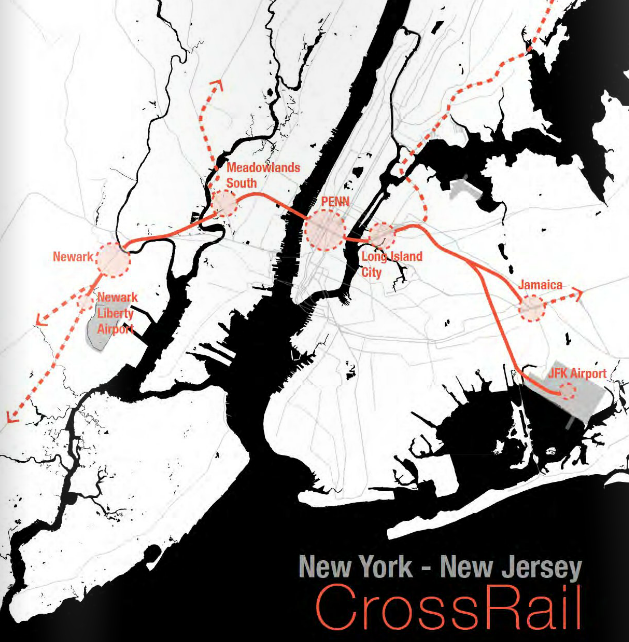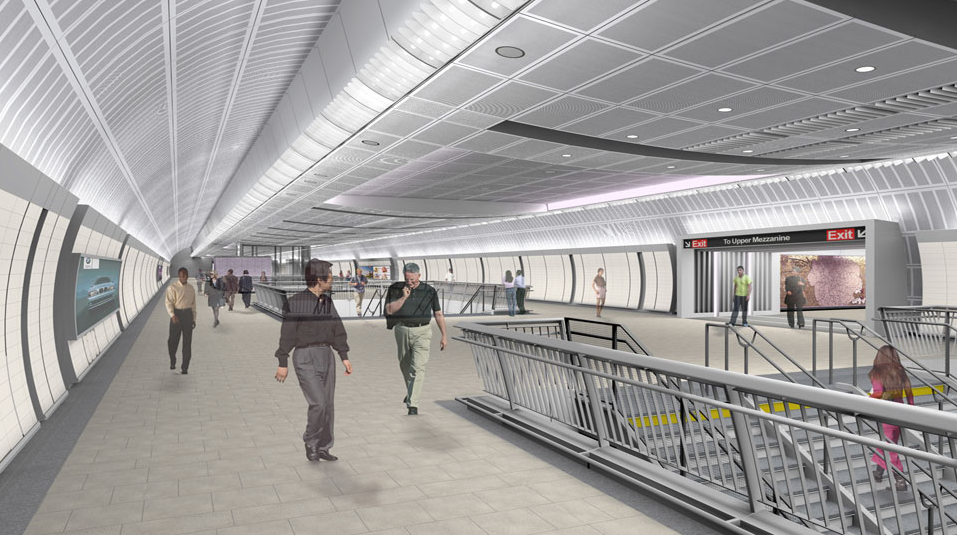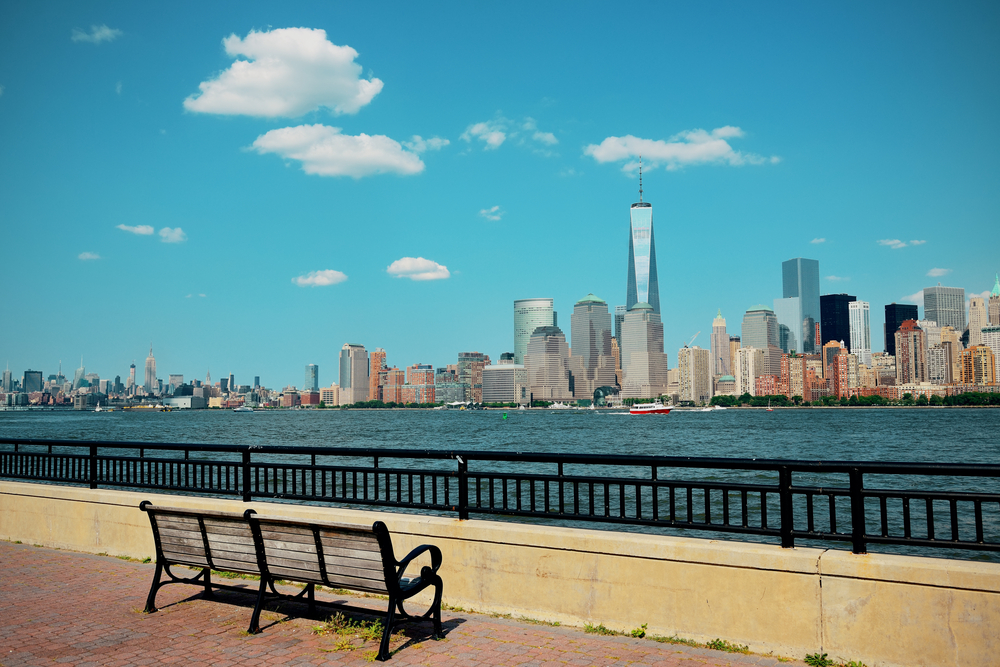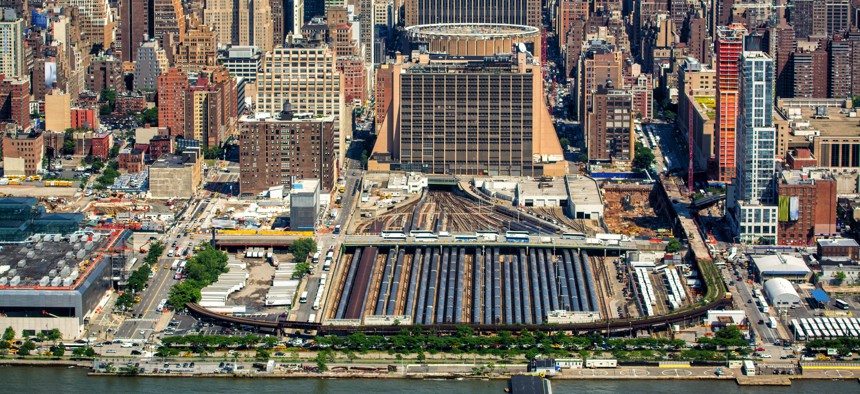Connecting state and local government leaders
The New York City region needs significant transit infrastructure investments to stay competitive. Can “value capture” financing techniques emerge as an alternative to increased taxation?
Although New York Times editors didn’t deem it worthy of front page treatment, the top story of the day on for tens of thousands of workers in late July was captured in a Metro section headline: “Commuter Chaos as Electrical Problems Force New Jersey Train Delays.”
Perhaps it was the regularity of such rail-related disasters that consigned the story to the back of the newspaper. After all, people didn’t die as they had when an Amtrak train derailed in Philadelphia on May 12. Nor was all service through trans-Hudson rail tunnels suspended, as occurred in the wake of Hurricane Sandy in 2012.
Nonetheless, the electrical malfunctions in both tubes of the Hudson River tunnels on July 22 were another sign of the severe strains that afflict the ancient infrastructure of the New York metropolitan area.
Rail is particularly problematic, since it is essential not only to commuting throughout the region but also to the economy of the entire Northeast Corridor stretching from Boston to Washington, D.C.
No one disputes that major investments are needed to improve rail service in the New York City region. Rail lines are running at capacity during peak hours, so no more trains can be added. Subway and commuter rail cars are packed by standing-room-only crowds of harried travelers.
Amtrak has been warning that one or both of its Hudson River tunnels might need to be closed on short notice for emergency repairs because of damage from Sandy, and the June 22 incident validated the fear. The loss of just one day of service along the Northeast Corridor could cost $100 million in added congestion and lost productivity, according to a recent report from the Northeast Corridor Infrastructure and Operations Advisory Committee.
Such closures “would be devastating to the economy,” said Patrick J. Foye, executive director of the Port Authority of New York and New Jersey, in a recent interview. Already, said Foye, traffic congestion in the Northeast is costing its economy some $2 billion in lost productivity.
The metropolitan area’s economy, now contributing $1.5 trillion to the gross national product, could double over the next 25 years, experts say—if only workers can conveniently get to their jobs and travelers can move into and around the city by rail.
So the question becomes: How to finance the billions of dollars in needed investment when voters are so averse to raising taxes?
A bold answer to the question is found in a new study of the New York metropolitan area’s rail transit challenge. It was developed by a team at the University of Pennsylvania School of Design under the guidance of two distinguished planners: Robert Yaro, former head of the Regional Plan Association, and Marilyn J. Taylor, who was appointed dean of PennDesign in 2008 after practicing as a leading architect and urban designer at Skidmore Owings & Merrill.
The visionary “New York-New Jersey CrossRail” plan would solve the trans-Hudson problem that’s afflicting New Jersey commuters and Amtrak passengers and result in many billions of dollars of investment along new and improved rail lines running between Newark Liberty International Airport to the west and Long Island City and points to the east in Queens.

Among its ambitions is to create a huge new employment and residential complex in Secaucus, a New Jersey town just west of New York City—with canals and architecture of a quality that might create a “Venice on the Meadowlands.”
The $45 billion the plan requires for construction, and the many billions more needed to cover debt service on bonds that would be issued, would rely significantly on financing techniques variously called “value capture” and “tax-increment financing.” These money-raising systems, now finding favor in California and elsewhere, allow bonding against future revenues projected from real estate development over periods of up to 45 years.
Yaro and Taylor have found receptive audiences for the plan as they have briefed state, local and federal officials about its details. To these officials, many feeling “beaten down by years of infrastructure underfunding,” as Yaro says, the value capture technique seems attractive.
“There’s a tremendous need, hundreds of billions of dollars, across the nation,” said Foye, “and it is incumbent on public agencies to look at tax increment or value capture financing to help solve the problem.” Foye pointed to one large project in Manhattan that is using value capture: the extension of the Metropolitan Transportation Authority’s No. 7 subway line to 11th Avenue and 34th Street on the West Side.

Meeting the Need
The two existing trans-Hudson tunnels opened 105 years ago as part of the Pennsylvania Railroad’s ambitious infrastructure project that included Pennsylvania Station in Manhattan.
Officials have long foreseen the need to replace the aging tunnels, now controlled by Amtrak. Federal, state and local funds were largely in place to construct a new, two-tube tunnel as part of a project titled Access to the Region’s Core (ARC), which would have given New Jersey Transit its own Midtown Manhattan terminus adjacent to Penn Station.
But that $8.7 billion plan went asunder in October 2010, when New Jersey Gov. Chris Christie withdrew his support and decided to spend federal funding earmarked for the project on road repairs and other highway projects instead.
Christie faced intense criticism for canceling what was considered a critically important infrastructure project. U.S. Sen. Charles Schumer of New York slammed the New Jersey governor for his “terrible, terrible” decision. Ray LaHood, then the U.S. transportation secretary, said that he was “extremely disappointed” in Christie’s move, which he described as “a devastating blow to thousands of workers, millions of commuters and the state’s economic future.”
(Last week, Christie, who is running for president, said he supports new rail tunnels from his state to Manhattan.)
In the wake of the ARC cancellation debacle, Amtrak developed its Gateway project to build two new rail tunnels at a cost of $7 billion to $10 billion. If funded on Amtrak’s schedule the tunnels would open in 2024, six years after scheduled completion of the now-defunct ARC project. Opening of the tunnels would allow refurbishing of the existing tubes, doubling trans-Hudson rail capacity. The federal contribution to the Gateway project would come from the big infrastructure financing package that’s been beating a tortuous path through Congress. (But, in a sign of the times, the Republican House of Representatives in June passed a bill cutting fiscal 2016 spending on Amtrak by $250 million. President Obama has proposed to spend $2.45 billion, $1 billion more than this year.)
Saying that the two existing tunnels “are the most significant choke point along the entire Northeast Corridor,” CrossRail’s authors see the new tunnels as essential to their plan.
They would extend the new rail lines east, beyond Penn Station and through new tunnels under the East River into Queens, with new stations at Long Island City and Sunnyside in Queens. The new line would provide connections to JFK Airport and to the Bronx, New York’s Westchester County and commuter-heavy cities in Connecticut.
On the New Jersey side of the river, CrossRail would run two new lines to Secaucus and beyond to Newark Penn Station—providing significant new development and commuting opportunities. And train service would connect Newark Airport directly, with one-seat service to Manhattan and beyond.
The plan envisions construction of a new “Penn South” rail station in Manhattan and a reconfiguration of the existing Penn Station track layout to accommodate the increase in rail capacity.
The CrossRail project, says its report, will offer service with frequencies as short as three minutes between trains at every station within the core, “enhancing region-wide accessibility like never before.” By the year 2040, the project would almost double capacity with 28 new trains an hour the report projects. The system would handle an estimated 360 million trips per year.
CrossRail’s supporters say the project would make it more affordable for people of modest means to reach jobs throughout the area. And that would be essential to the economic growth planners foresee for the New York area.
A Grand Vision for Transit-Oriented Development
New transportation projects, whether highway or rail, nearly always bring added economic development along their routes. Washington, D.C.’s Metrorail system has brought billions of dollars in new development in Virginia and Maryland as well as in the District of Columbia. In Tucson, Arizona, a brand-new streetcar project is helping to revitalize the city’s downtown area.
The CrossRail planners project many billions of dollars in private investment along the path of the rail projects they would like to see. “Development of key station locations is central to realizing the project’s full potential,” says the report.
It projects significant new investment around existing station areas at Newark Penn Station and Secaucus in New Jersey, and Penn Station and Jamaica in New York. New stations at Sunnyside Yards and Jamaica, in Queens, and improved service at other stations along the line, should also produce new investment in commercial and residential buildings.
The PennDesign team chose Secaucus for a detailed study of the economic development that could ensue from the improved transit they envision. The suburban town now has about 17,000 residents. Some of it lies within the 100-year flood zone. The team would rechristen Secaucus as “Meadowlands South,” seeing an opportunity “to create a new walkable urban center organized around transit and planned and designed to “live with the water” alongside one of the region’s most important ecological resources, the New Jersey Meadowlands.
Development would center around New Jersey Transit’s existing Frank R. Lautenberg Station, replacing low-density warehouses that now surround it. The planners say that Meadowlands South could accommodate at least 27 million feet of office space, 40,000 residential units and 2.8 million square feet of retail. The area offers “a unique opportunity for the clean-slate development of a new central business district equal in size to Lower Manhattan,” the report says. Its “orientation to water” will be a distinctive feature, with plans for environmental remediation and construction of canals to manage water flows and create a new “Venice-on-the Meadowlands.”

Management and Financing
With two states, several municipalities, several transit agencies, other state and bi-state authorities, not to mention the federal government, as key players, the project would need new administrative structures. They would need approval by the New York and New Jersey legislatures, and Washington would also play a key role.
The Port Authority of New York and New Jersey has a long history of building huge projects and thus might seem suitable to manage the CrossRail project. But it lacks funding sources and taxing authority sufficient for the task, the report concludes.
As we sat in a conference room overlooking the World Trade Center construction site, with its dramatic view of the memorial fountains now flowing into the footprints of the two huge buildings destroyed in the September 11, 2001, terrorist attacks, and of the towering One World Trade Center building at the heart of the downtown redevelopment, Foye confirmed the CrossRail planners’ observation that the authority he runs is hardly flush with cash. Many billions of dollars have been spent over the past decade to build the huge new One World Trade Center, a striking (and costly) transit station and other facilities on the site.
Finally, these expenditures, which Foye characterized as important to the city and the nation, are coming to an end, allowing the Port Authority to return to its “core mission” of transportation infrastructure, he said.
But Foye observed that the Port Authority has many calls on its capital budget, which is slated to spend $27.6 billion from 2014-2023. They include raising the roadway on the Bayonne Bridge between New Jersey and Staten Island to accommodate the taller ships that will be transporting cargo from Asia to the East Coast once the Panama Canal widening project is completed next year.
Reconstructing the Goethals Bridge, which also connects New Jersey and Staten Island, is also on the agenda, as is replacing suspender ropes on the George Washington Bridge connecting New York City with Fort Lee, New Jersey.
The Port Authority also has allocated a lot of money to its aviation duties, including expensive terminal redevelopments at both Newark and LaGuardia airports. Transit projects include a $1.2 billion extension of the PATH rail system to Newark Airport—but they command a small share of the total capital budget.
Three quarters of the Port Authority’s operating revenues, some $4.7 billion this year, derives from tolls and fares and rentals of One World Trade Center offices. Aviation and parking fees account for most of the rest. With the recent opening of the observation facilities at the top of One World Trade Center, the Port Authority has a new source of revenue, Foye noted.
Some 60,000 people a week take the high-speed elevators to the top of the building, he said, to partake in what the observatory website calls “One Of The Hottest New Travel Experiences In The World.” Prices for single tickets are $32 for an adult, $30 for a senior and $26 for a child—suggesting that this new revenue stream could approach $75 million a year.
Foye is employing public-private partnerships in some of his projects and he is considering using value capture financing to pay for some of the costs of extending PATH rail services to Newark Airport. He pointed to the New York Transit Authority’s $2 billion extension of the No. 7 subway line to Hudson Yards as an example of value capture in action.
The CrossRail planners likewise focus on the Hudson Yards project as an example both of value capture and of the kind of administrative structure that might work for CrossRail.
To run the project, New York City created the Hudson Yards Infrastructure Corporation, which issues municipal bonds to be paid back by value capture revenue streams. Another entity, the Hudson Yards Development Corporation, manages the infrastructure construction.
“The subway extension, other public improvements, and the rezoning of the district will support millions of square feet of new mixed-use developments that will generate economic activity that more than covers the cost of improvements,” the CrossRail report says.
CrossRail planners propose a new bi-state authorizing entity, and creation both of an NY-NJ CrossRail Corporation to design, build and contract for the infrastructure and of a Public Finance Authority to issue bonds and manage revenues.
The project would look to Washington for roughly 40 percent of its construction financing, half from grants and half from loans. Of the remaining 60 percent, half would be raised through local value capture—with allocation to the project’s construction costs of 30 percent or the increased flow from property taxes and other fees resulting from the kind of vibrant real estate development anticipated in Secaucus. Loans from the two states and a $2 billion contribution from the Port Authority would make up the rest of the $45 billion needed to build the project.
Over the assumed 30-year term of bonds issued to finance construction, nearly three quarters of debt service in the $40 billion range would come from property tax increments flowing from development around new and improved transit stations.
Remaining a World-Class City
The kind of sweeping vision embodied in the CrossRail proposal is not consonant with today’s political climate and discourse—as Congress’s desultory infrastructure financing debate has been demonstrating.
Nor would it readily adapt to the fragmented nature of our political system, with so many levels of government and various special authorities having a say in so many decisions that would be needed to make CrossRail a reality.
Regulatory hurdles for large projects are legion—so much so that President Obama undertook a special effort to speed up clearance for key projects like Amtrak’s Gateway project to increase trans-Hudson tunnel capacity. High-priority infrastructure initiatives needing speedy regulatory review are now listed on a special federal dashboard.
But ambitious action like that in the CrossRail proposal is essential, says Yaro, if New York is to remain competitive among leading cities around the world. Both Paris and London are engaged in $50 billion infrastructure improvement plans, he noted. Hong Kong is also among cities with infrastructure programs aimed at competing for tomorrow’s wealth.
The New York-New Jersey Crossrail plan borrows both its name and a lot of ideas from London’s $22.5 billion CrossRail program, first proposed in 1943, and now set to open in 2018. The new, two-track tunnel will run from the city’s western suburbs and Heathrow Airport through central London to Canary Wharf and beyond. Transforming mobility across Greater London, it will foster London’s continued economic growth for years to come, according to its supporters.
“The project is a foundation for the UK government’s plan to enable London to overtake New York as the world’s premier financial capital by 2050,” says the CrossRail report.
Yaro says past PennDesign studio projects have wielded influence among infrastructure agencies, pointing to a 2010 project on high-speed rail in the Northeast Corridor that served as inspiration for the Federal Railroad Administration planning on the issue. He hopes public officials will also see merit in the CrossRail report.
And perhaps public opinion will shake politicians’ inertia, as the media increasingly focus on the looming Northeast Corridor rail disaster. The New York Times turned its attention to the larger problem on July 27, prominently displaying a detailed story headlined: “Aging Infrastructure Plagues Nation’s Busiest Corridor.”
Timothy B. Clark is Editor at Large at Government Executive’s Route Fifty and is a fellow at the National Academy of Public Administration.

NEXT STORY: Feds Increasingly Frustrated With Lack of State Action on Hudson River Tunnels




